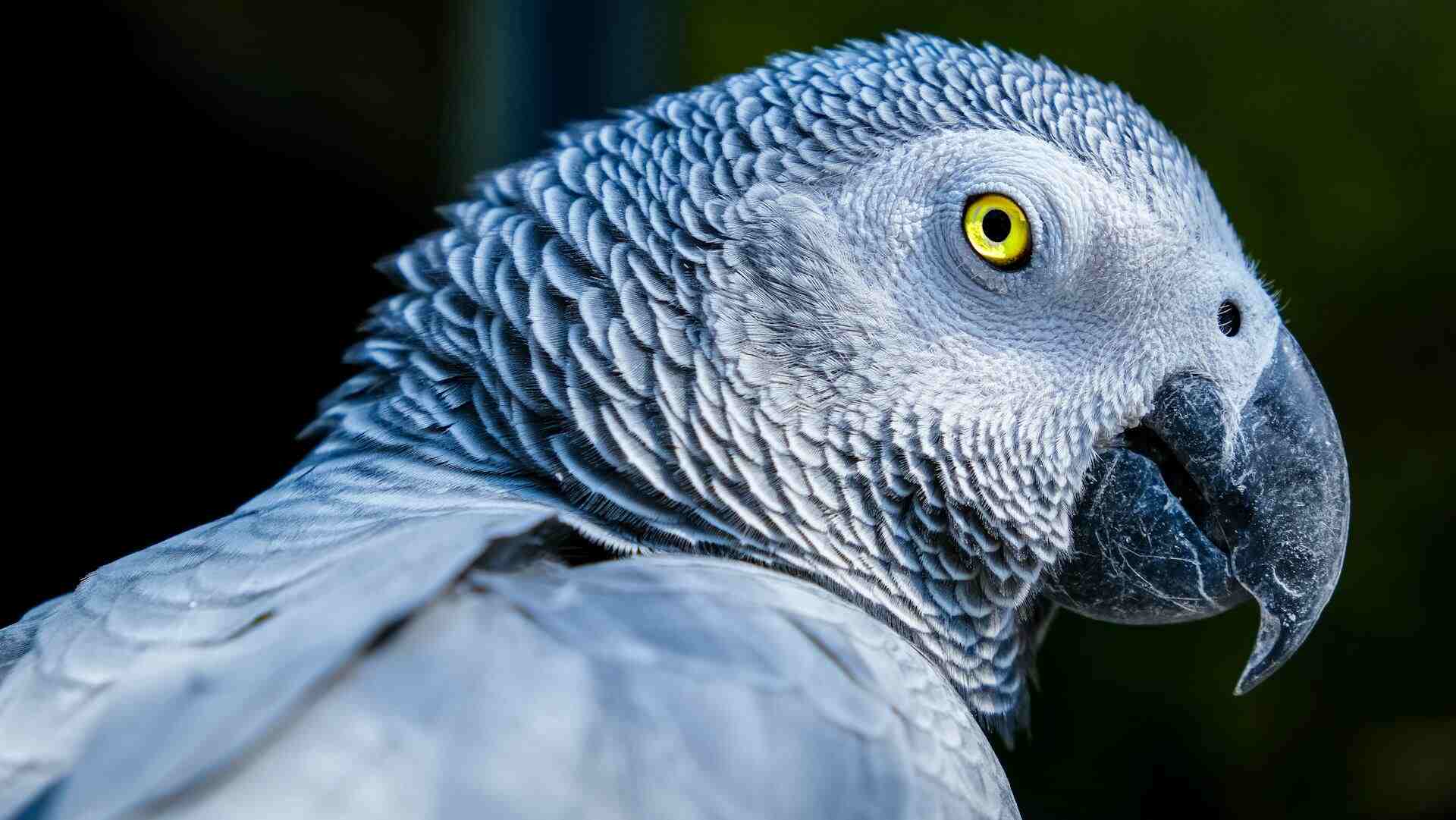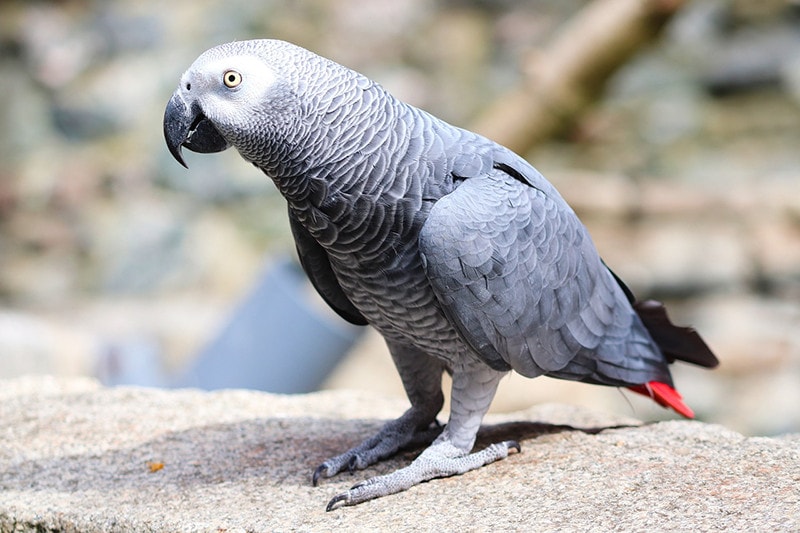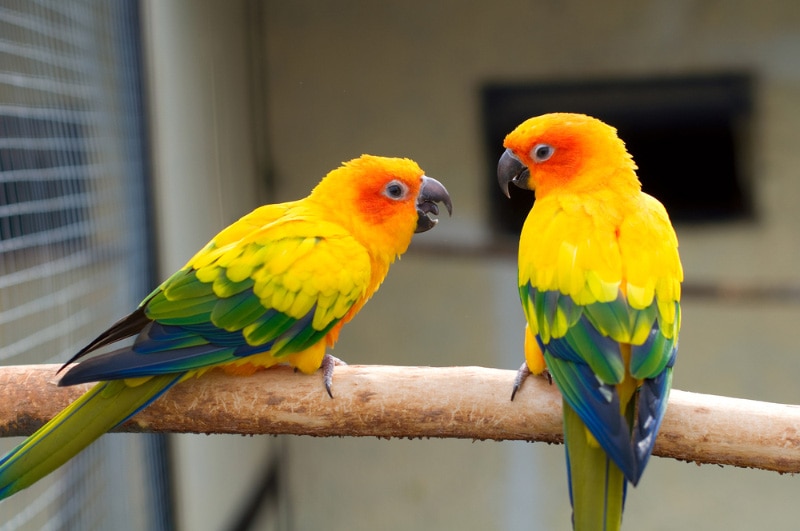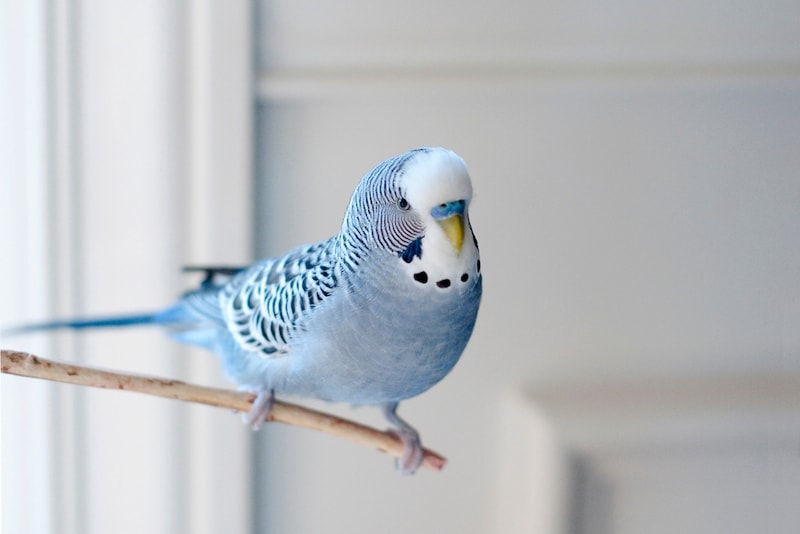African Grey Parrot: Pictures, Info, Diet & Care Guide
Updated on

Click to Skip Ahead
Introduction
Gray may be the most neutral of colors, but the African Grey parrot is anything but boring. This gorgeous bird is considered one of the smartest in the avian world, with unmatched vocal abilities and a brain that’s constantly working. The African Grey parrot can form close bonds with their humans, making them a unique and demanding pet.
Unfortunately, their popularity as pets has contributed to the huge reduction in the wild population of African Grey parrots. The species is endangered and is now listed under CITES (Convention on International Trade in Endangered Species of Wild Fauna and Flora) Appendix 1, along with other species threatened with extinction. This is the highest category of protection under the convention.
Species Overview
| Color: | Grey with red tail feathers |
| Size: | 13” |
| Weight: | 15 – 18 oz |
| Wingspan: | 18 – 20.5” |
African Grey parrots are prized for their intelligence and their ability to mimic sounds and voices. They’re known for their sensitivity to human emotions, and the brilliant birds are among the most social and interactive of all parrots.
However, owning an African Grey is a major commitment that should never be undertaken lightly. They require more daily care than many other pet birds and frequently outlive their owners thanks to their long lifespan. Keep reading to learn all about the prominent personality and attention needs of the African Grey parrot.
African Grey Parrot Characteristics
History & Natural Habitat

There are two species of African Grey parrots commonly kept as pets. Congo African Grey parrots are native to central Africa, while the smaller Timneh African Grey hails from western Africa.
In the wild, African Greys live primarily in forests and woodlands, spending most of their time in trees. They roost in large groups at night and forage for food during the day. African Grey parrots mainly eat seeds, nuts, and fruit.
African Grey parrots are incredibly vocal birds. They form dedicated breeding pairs, and males and females help care for the young. Wild African Grey parrots are endangered due to habitat loss and the international pet trade. As a responsible parrot parent, you must ensure that your parrot is captive bred and comes from a reputable breeder. They need to have all the necessary papers your country or state requires by law.
Things to Know When Owning an African Grey Parrot
Temperament
African Grey parrots are generally thought to be one of the smartest birds in the world. Research suggests that they learn to mimic words, understand what they’re saying, and often speak in complete sentences.
African Grey parrots are also sensitive and social and frequently form strong bonds with their owners. They crave daily interaction and exercise. Without it, they become much less charming and are far more demanding and destructive.
Early and frequent socialization is vital for the African Grey parrot. When properly socialized, they can be affectionate and playful family pets. However, they are not the most adaptable birds and require a consistent daily routine.

Sounds, Speech & Vocalizations
African Grey parrots are not quiet birds. Not only can they learn human words, but they can also imitate sounds like sirens and ringing phones. African Grey parrots also display a wide range of natural vocalizations, including shrieks, squawks, whistles, screams, and even growls.
They use these sounds to communicate among themselves and with their human family. Bored African Grey parrots won’t hesitate to express their frustration vocally.
African Grey Parrot Appearance
Congo and Timneh African Grey parrots differ slightly in their appearance. They were once considered sub-species but are now classified as separate species. Congo parrots are the larger of the two. They are uniformly gray all over their bodies except for a bright red tail and a black beak.
The Timneh species are smaller with darker Grey feathers. Their tail feathers are also darker, closer to maroon than red. Timneh African Grey parrots also have horn colored beaks with black coloring on the sides. Both species have gray legs with two toes facing forward and two backward.
Caring for the African Grey Parrot
Because of their intelligence and sensitivity, African Grey parrots are one of the more demanding pet bird species with their care needs. They are generally not recommended for inexperienced bird keepers. Here’s what you need to know about caring for an African Grey parrot.

Diet & Nutrition
An exotics veterinarian can help you formulate a healthy diet for your African Grey parrot. These birds can safely consume a wide range of foods but are prone to obesity and vitamin deficiencies if they don’t eat the correct diet. They may also have different nutritional requirements at specific life stages or if they are sick and stressed.
A nutritionally balanced pellet diet should make up most of the African Grey parrot’s daily diet. They can also be offered a small amount of seeds and nuts to reproduce their natural diet. African Grey parrots can also eat small amounts of vegetables and fruits that are washed and chopped.
Rotate the types of seeds, nuts, fruits, and vegetables you offer your bird to keep them from developing favorites and ignoring the rest. A well-balanced varied diet is essential to keep your African Grey parrot healthy.
Cage/Housing Requirements
African Grey parrots are medium-sized birds but will still need a relatively large cage. Your bird needs a cage with enough space to fully spread their wings without touching the sides. Plan on purchasing a cage at least 36”x 36” x 48”, but the more space you can provide, the better.
You’ll also need a cage with enough space to provide your African Grey parrot with multiple perches, chew toys, and other enrichment objects. They need to spend a lot of time out of their cages each day but also stay busy when they’re in their enclosure.
Place the cage in a warm spot in your house, away from direct sunlight. African Grey parrots like to be involved in family life, so try to locate the cage somewhere quiet but not isolated from daily activities.

Exercise
No matter how comfortable you make their cage, an African Grey parrot still needs to spend a lot of time outside of it each day. They should get at least 2 hours of exercise a day in a safe location where they can stretch their wings. Supervise your bird during their time outside the cage to prevent injury or mischief.
Mental stimulation is just as important as physical stimulation for the intelligent African Grey parrot. They are social animals and when kept on their own in a house you become their social outlet. They need at least 5 hours of interaction and stimulation each day to prevent boredom and behavioral issues. This includes time to fly and exercise, one-on-one interaction with humans, training, and playing with puzzle toys or other enrichment activities.
Health & Conditions
African Grey parrots are most prone to health conditions related to nutrition and behavior. They should receive regular checkups and preventive care with an avian veterinarian.
- Proventricular dilatation disease (PDD)
- Respiratory disease and nasal blockages
- Psittacine beak and feather disease (PBFD)
- Obesity
- Behavioural problems e.g.excessive feather-picking

3 Little-Known Facts About The African Gray Parrot
1. They Can Develop a Large Vocabulary.
With dedicated training, African Grey parrots can learn as many as 1,000 words. They don’t just mindlessly mimic the sounds, either. These geniuses of the bird world genuinely seem to understand how to use words in the proper context and even in sentences.
2. They May Be Able to Recognize Colors, Numbers and Shapes.
Although research is still limited, scientists studying African Grey parrots believe they can distinguish between colors, recognize shapes, and identify numbers.
3. They Rarely Touch the Ground.
In the wild, African Grey parrots are almost exclusively treetop dwellers. They roost, feed, and spend all their time high up in trees. Their feet and powerful beaks allow them to climb and balance with ease.
Conclusion
There’s no pet quite like an African Grey parrot, but you must know what you’re getting into before committing to one. They’re fascinating, beautiful birds that are highly intelligent, long lived and have very specific and demanding care needs. With a lifespan frequently reaching 50-80 years, the African Grey parrot is the definition of a lifetime commitment.
Related Read: How Much Does an African Grey Parrot Cost?
Featured Image Credit: Magda Ehlers, Pexels












